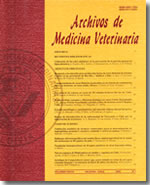Bruising in lamb carcasses and its relationship with transport
Main Article Content
Abstract
The study was undertaken at one of the main slaughterplants of the Magallanes Region, in Chile. A total of 39,301 lamb and mutton carcasses were observed during the regular commercial slaughter, and the proportion of bruised carcasses was determined. The main characteristics of the vehicles and stocking densities used for the transportation of sheep was described; the sheep proceeded directly from farms located at distances up to 400 km. Of all carcasses observed, 7.5% presented bruises; of the bruised carcasses 4.5% were classified as grade 1 (only subcutaneous tissue affected), 3% as grade 2 (subcutaneous and muscular tissues affected) and 0.005% as grade 3 (also bone affected). In terms of the approximate diameter of the lesions, 48% of them were classified as extension 1 (< 5 cm of diameter), 45% as extension 2 (6 to 10 cm of diameter) and only 7% as extension 3 (> 10 cm of diameter). The loin was the most commonly affected anatomical region in the carcass, concentrating 51.03% of the lesions. According to the transport distance, 7.6 and 8.1% of bruised carcasses were found in lambs that had been transported for 200-299 km and 300-400 km, respectively; in contrast 6.1% and 6.7% of bruised carcasses were found in lambs transported for 0-99 km and 100-199 km, also respectively. The stocking densities registered were in the range of 4.5 to 6.1 lambs/m2 (with a mean live weight of 28.5 kg) and 3.8 to 5.3 mutton/m2 (with a mean live weight of 37.9 kg). It was concluded that the relatively low percentage of bruised carcasses found, with small lesions of reduced extension, is mainly attributable to the adequate structure of vehicles used for transport and the short distances travelled by the sheep.

